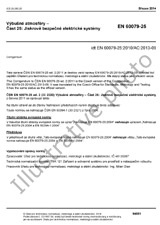We need your consent to use the individual data so that you can see information about your interests, among other things. Click "OK" to give your consent.

IEEE 802.1CB-2017
IEEE Standard for Local and metropolitan area networks--Frame Replication and Elimination for Reliability
Translate name
STANDARD published on 27.10.2017
The information about the standard:
Designation standards: IEEE 802.1CB-2017
Publication date standards: 27.10.2017
SKU: NS-800374
The number of pages: 102
Approximate weight : 337 g (0.74 lbs)
Country: International technical standard
Category: Technical standards IEEE
Annotation of standard text IEEE 802.1CB-2017 :
New IEEE Standard - Active.
This standard specifies procedures, managed objects, and protocols for bridges and end systems that provide identification and replication of packets for redundant transmission, identification of duplicate packets, and elimination of duplicate packets. It is not concerned with the creation of the multiple paths over which the duplicates are transmitted. (The PDF of this standard is available at no cost at />
ISBN: 978-1-5044-4298-5, 978-1-5044-4297-8
Number of Pages: 102
Product Code: STDPD22761, STDGT22761
Keywords: Bridged Local Area Networks, Bridges, Bridging, Frame Elimination, Frame Replication, IEEE 802®, IEEE 802.1CB™, IEEE 802.1Q™, local area networks (LANs), MAC Bridges, Redundancy, Time-Sensitive Networking, TSN, Virtual Bridged Local Area Networks (virtual LANs)
Category: 802.1
We recommend:
Technical standards updating
Do you want to make sure you use only the valid technical standards?
We can offer you a solution which will provide you a monthly overview concerning the updating of standards which you use.
Would you like to know more? Look at this page.



 Cookies
Cookies
